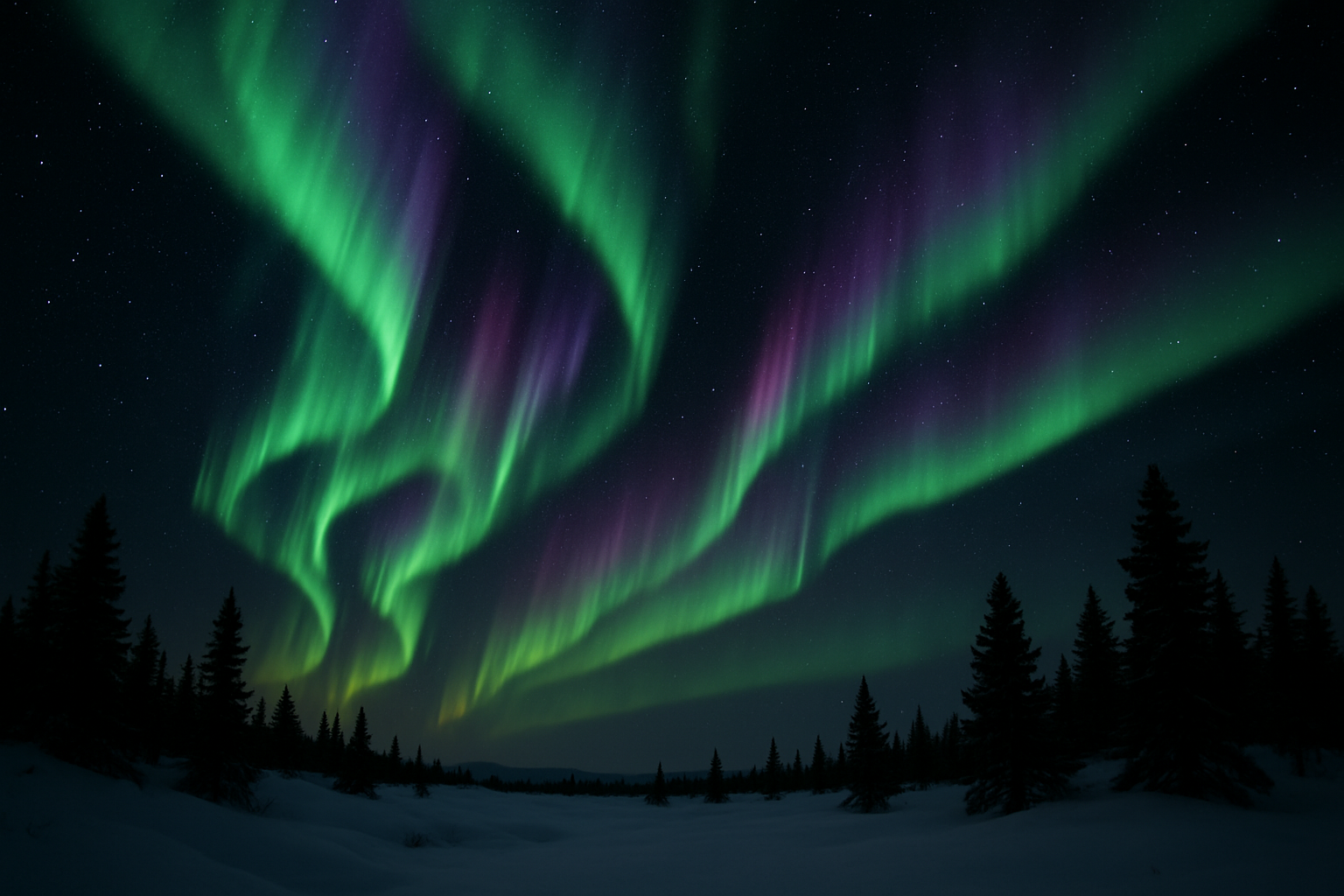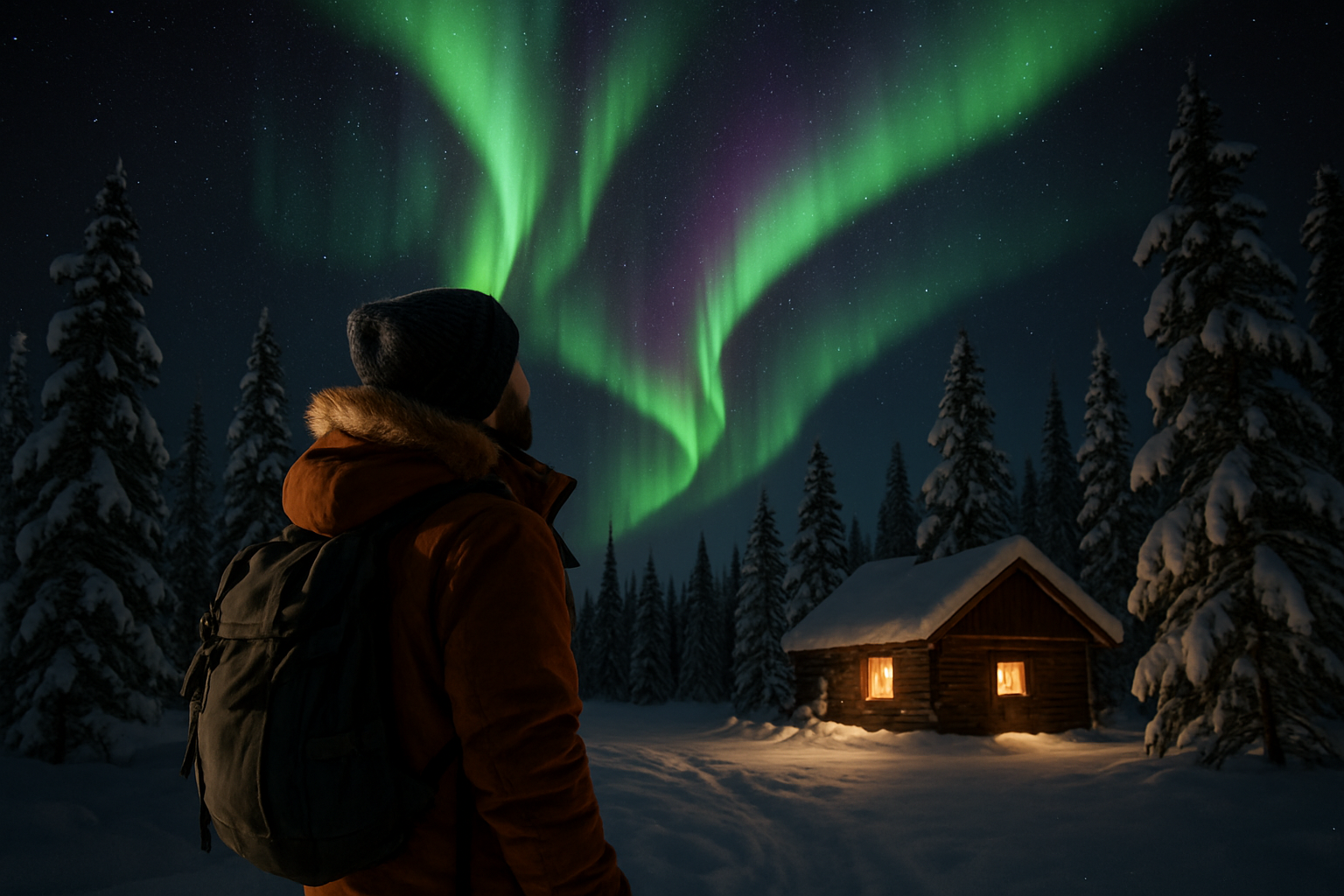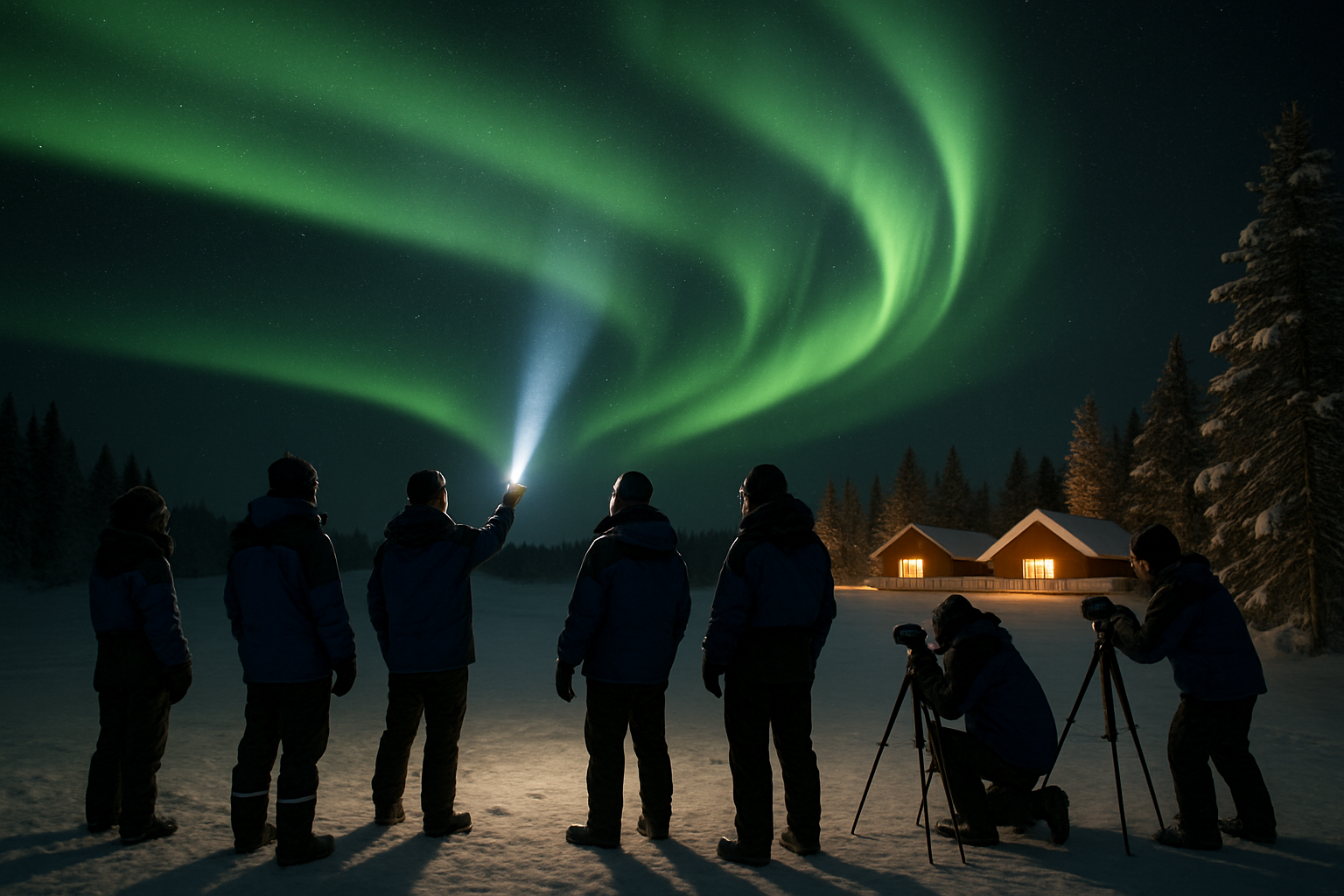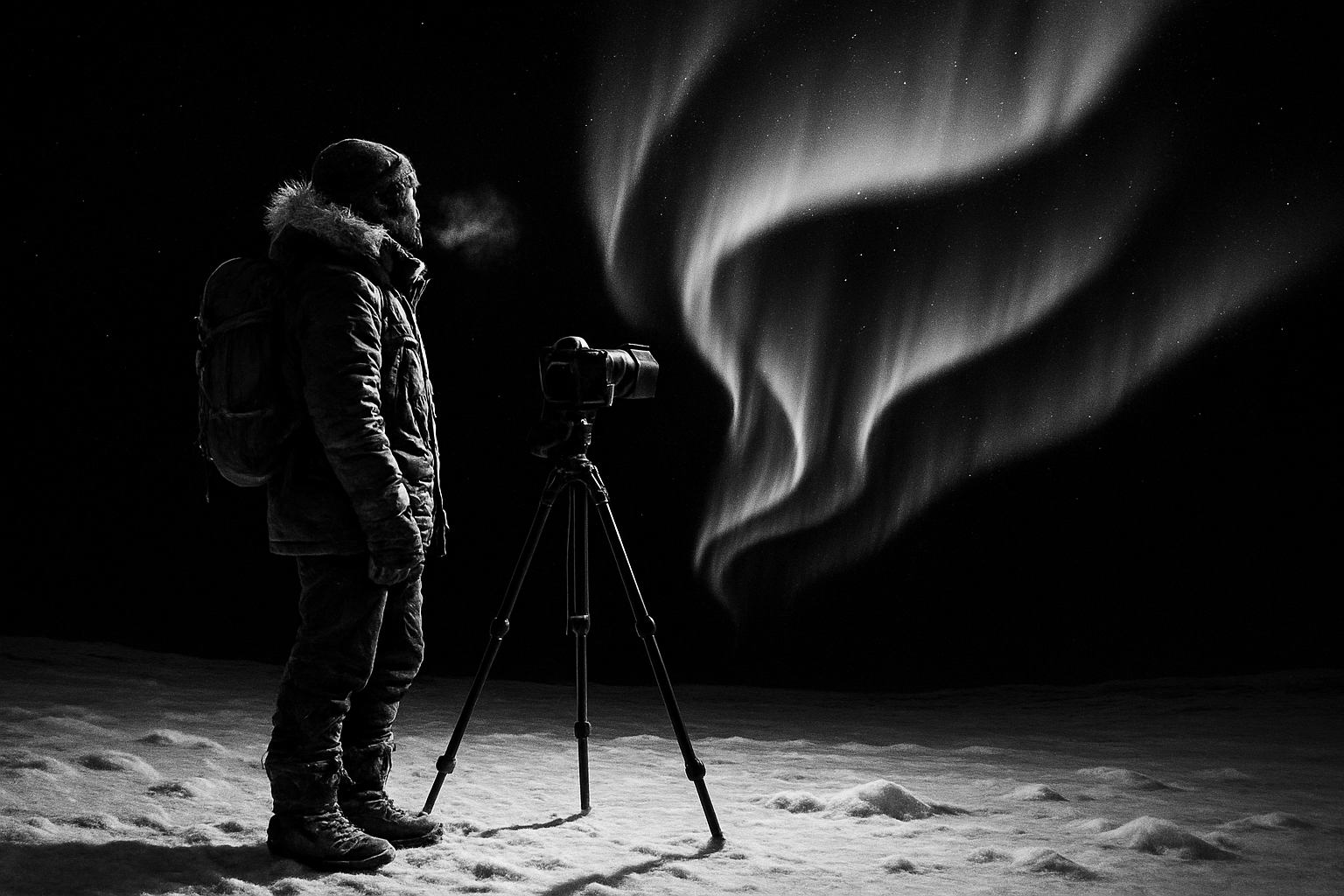Picture yourself beneath a sky alive with swirling green and purple lights, a moment many dream of but few truly experience. Planning an aurora borealis trip in 2025 might seem overwhelming, but this guide breaks it down step by step. We’ll explore the science, share the best places and times to go, and help you pick the right gear and tours. Whether you crave adventure or quiet wonder, you’ll find everything you need to start your own unforgettable journey. Ready to make your aurora borealis trip a reality? Let’s dive in and turn that dream into a plan.
Understanding the Aurora Borealis: Science, Myths, and Magic
Imagine embarking on an aurora borealis trip and witnessing the sky shimmer with vibrant colors. This spectacle is more than just a beautiful display; it's a fascinating scientific phenomenon shaped by our sun and Earth's atmosphere.

What Causes the Northern Lights?
The aurora borealis begins with solar winds—charged particles ejected from the sun. When these particles reach Earth, they interact with gases in the upper atmosphere, especially near the magnetic poles.
During geomagnetic storms, these interactions intensify, causing more vivid auroras. The colors you see depend on which gas is involved: oxygen creates green or red, while nitrogen produces blue or purple hues.
This dance of particles and energy is what makes an aurora borealis trip so captivating for travelers and scientists alike.
Myths and Legends from Around the World
Throughout history, cultures have woven the northern lights into their legends. The indigenous Sami people of Lapland believed the aurora was a spiritual force—sometimes a sign of good fortune, other times a warning. Norse mythology described the lights as reflections from Valkyries’ armor, while Inuit tales saw them as spirits playing in the sky.
To explore more about how different civilizations interpreted this phenomenon, check out this overview of Aurora Borealis myths and legends.
No matter the story, these legends add a magical layer to every aurora borealis trip.
The Best Conditions for Viewing
Catching the lights requires planning. The best chance for a successful aurora borealis trip comes when the sky is dark, clear, and free from light pollution. Rural locations far from cities are ideal.
Solar activity peaks every 11 years, with 2024–2025 being especially active. Monitoring the Kp index—a scale from 0 to 9—helps predict aurora strength. Aim for Kp 4 or higher for the brightest displays.
The Emotional and Cultural Impact
Witnessing the aurora is often described as life-changing. Travelers report feelings of awe and connection to nature. In surveys, 90% of respondents say seeing the northern lights is a top life experience.
Whether you’re on your first aurora borealis trip or your tenth, the emotional impact is undeniable. Many return home with a deeper appreciation for both science and culture.
Common Misconceptions
It’s easy to believe the aurora is always visible in the Arctic, but this isn’t true. Even in prime locations, you might not see the lights every night. Weather, solar activity, and timing all play a role.
A successful aurora borealis trip requires patience, flexibility, and realistic expectations. Don’t fall for the myth that it’s a nightly guarantee—even during peak season.
Planning Your Aurora Borealis Trip: When, Where, and How
Dreaming of an aurora borealis trip in 2025? Smart planning is the key to making those shimmering lights a reality. From picking the right dates to choosing the perfect destination, let’s break down each step so your adventure is unforgettable and stress-free.

When Is the Best Time to See the Northern Lights?
The best months for an aurora borealis trip are September through March, when nights are longest and skies are darkest. Winter, especially from December to February, offers the highest chances due to extended darkness and frequent clear skies.
Regional differences matter. In Finnish Lapland, for example, clear winter nights can bring an 80% chance of seeing the aurora. Watch for new moon phases to maximize darkness, and keep an eye on local weather—clouds can block even the brightest display.
Solar activity peaks every 11 years, and 2024–2025 is a maximum, making this the ideal window for your aurora borealis trip.
Top Destinations for Beginners
Choosing the right destination can make or break your aurora borealis trip. Popular spots include Finnish Lapland, Tromsø in Norway, Abisko in Sweden, Iceland, and Alaska. Each offers unique benefits, from accessibility to local culture.
Here’s a quick comparison:
| Destination | Accessibility | Aurora Nights/Year | Unique Feature |
|---|---|---|---|
| Rovaniemi | Facile | 200+ | Santa’s hometown |
| Tromsø | Moderato | 180+ | Arctic city life |
| Abisko | Moderato | 150+ | Blue hole microclimate |
| Iceland | Facile | 120+ | Volcanic landscapes |
| Alaska | Varied | 100+ | Wilderness lodges |
For those interested in Rovaniemi, Rovaniemi Northern Lights experiences showcase top tours and viewing spots, perfect for a first aurora borealis trip.
How to Choose the Right Base
Your base location can make your aurora borealis trip more comfortable and successful. The best spots are close to the auroral oval and far from city lights.
Accommodation options range from cozy hotels to glass igloos, wilderness cabins, and luxury lodges. Think about how you’ll get around—some areas need a rental car, while others offer guided tours or local shuttles.
Access to guided excursions is crucial for maximizing your chances during an aurora borealis trip.
Budgeting and Trip Duration
For a successful aurora borealis trip, plan a stay of at least 3–5 nights. This increases your odds of clear weather and seeing the lights.
Here’s a sample cost breakdown:
- Flights: €300–€800 per person
- Accommodation: €75–€300 per night
- Tours: €100–€200 per night
- Gear rental: €50–€100 for the trip
An average 4-night aurora borealis trip runs €1,200–€2,500 per person, depending on your choices.
Booking in Advance and Seasonal Demand
Booking early is vital for your 2025 aurora borealis trip. Solar maximum years bring huge demand, and the best accommodations and tours fill up months ahead.
Look for deals 6–12 months before your trip. Early booking not only secures your spot but can also unlock discounts or package savings.
Peak season (December to March) sees the most competition, so don’t wait to plan your aurora borealis trip.
Essential Travel Documents and Insurance
Every aurora borealis trip to the Arctic requires proper documents. Check visa requirements for your nationality—Finland, Sweden, Norway, and Iceland are all Schengen countries, while Alaska requires a US visa or ESTA for many travelers.
Comprehensive travel insurance is a must. It should cover winter activities, potential delays, and health emergencies. Keep digital and printed copies of your documents handy throughout your aurora borealis trip.
Choosing the Right Aurora Tour: Guided Adventures vs. DIY Experiences
Planning the perfect aurora borealis trip means deciding whether to join a guided adventure or strike out on your own. Each approach offers unique benefits and challenges, so understanding your options is key to maximizing your chances of seeing the Northern Lights.

Pros and Cons of Guided Tours
Guided tours are the most popular choice for many planning an aurora borealis trip, especially beginners. The main advantage is expert guidance—local guides know the best viewing spots and how to interpret aurora forecasts. They handle transportation, safety, and logistics, taking the stress out of Arctic travel.
Many guided tours boast impressive success rates. In Finnish Lapland, for example, some operators report a 95% or higher chance of seeing the aurora on clear nights. Group tours offer a social experience, while private tours provide exclusivity and flexibility.
However, guided tours can be more expensive and less spontaneous than DIY options. You’ll follow a set itinerary, which might mean less freedom if you want to explore on your own. Still, for those prioritizing reliability and comfort, guided tours are hard to beat.
DIY Aurora Hunting
Prefer a more independent aurora borealis trip? DIY hunting lets you chase the lights at your own pace. With the help of aurora forecast apps, maps, and online resources, you can plan nightly outings based on real-time data. Renting a car provides maximum flexibility, allowing you to reach remote, dark-sky locations.
DIY trips are often more budget-friendly and customizable. However, they come with challenges. Navigating icy roads, reading weather patterns, and staying safe in subzero temperatures require preparation. Remote areas may have limited cell coverage and emergency services.
If you’re confident in your research and love adventure, DIY aurora hunting can be deeply rewarding. Just remember to prioritize safety and have a backup plan in case the weather doesn’t cooperate.
What to Look for in a Tour Operator
Choosing the right tour operator can make or break your aurora borealis trip. Look for companies with strong local expertise, positive customer reviews, and proper safety certifications. Experienced guides not only increase your chances of witnessing the aurora, but also help you capture it with photography tips and the right equipment.
Value-added services such as thermal clothing, hot drinks, and flexible cancellation policies enhance your experience. Some operators even offer money-back guarantees if the lights don’t appear.
For a curated selection of guided options, explore top-rated Northern Lights tour packages that cater to all experience levels. Booking with a reputable provider ensures your trip is safe, comfortable, and memorable.
Unique Tour Experiences
An aurora borealis trip is about more than just the lights. Many tours offer unforgettable add-ons, like snowmobile safaris, reindeer sleigh rides, or overnight stays in glass igloos. Some include night photography workshops designed for beginners, so you can return home with stunning images.
Consider tours that immerse you in local culture—learn about Sami traditions, sample Arctic cuisine, or join a storytelling session under the stars. These experiences make your journey richer, whether or not the aurora appears.
With the right mix of adventure and cultural discovery, your aurora borealis trip becomes a once-in-a-lifetime memory.
Essential Gear and Preparation for Your Aurora Adventure
Preparing for your aurora borealis trip is just as exciting as the journey itself. The right gear and planning can mean the difference between a magical night under the lights and an uncomfortable experience. Let’s break down exactly what you need to know to stay warm, safe, and ready for the adventure of a lifetime.

Dressing for Arctic Conditions
Staying comfortable during your aurora borealis trip starts with smart layering. Begin with a moisture-wicking base layer, like merino wool, to keep sweat away from your skin. Add an insulating layer, such as down or fleece, for warmth. Top it off with a waterproof, windproof outer shell—Gore-Tex is a popular choice.
Don’t forget your extremities. Warm gloves or mittens, insulated boots, thick wool socks, and a thermal hat are essential. A balaclava or neck gaiter will protect your face from biting winds. Dressing in layers lets you adapt to changing conditions, so you’ll enjoy every moment under the northern sky.
Must-Have Gear for Aurora Viewing
Capturing the magic of an aurora borealis trip requires more than just warm clothes. A sturdy tripod is essential for steady night photography. Choose a camera with manual settings and bring extra memory cards.
A headlamp with a red light mode preserves your night vision while you move around. Pack a portable power bank to keep your camera and phone charged in the cold. Consider hand and toe warmers for added comfort during long nights outside. For those booking Lapland Northern Lights holiday packages, many operators include gear rentals, making it even easier to prepare.
Packing List for Beginners
Packing for your aurora borealis trip doesn’t have to be overwhelming. Here’s a quick checklist:
- Thermal base layers (top and bottom)
- Insulating mid-layers (fleece or down)
- Waterproof outer jacket and pants
- Wool socks, gloves/mittens, and hat
- Sturdy winter boots
- Camera, tripod, and spare batteries
- Headlamp (with red mode)
- Power bank
- Toiletries and personal medications
- Travel documents and insurance info
- Small first aid kit
Travel light, but don’t skip the essentials. Organize gear in waterproof bags to keep everything dry and accessible.
Renting vs. Buying Winter Gear
If you’re only planning one aurora borealis trip, renting winter gear can be a smart move. Most major aurora destinations offer rental services for boots, jackets, pants, and accessories. This saves space in your luggage and can be more cost-effective for short stays.
Buying gear makes sense if you plan to return or want items tailored to your fit. Compare rental prices with purchase costs before deciding. Rentals also reduce hassle at airports and ensure you have equipment suited for local conditions.
Health and Safety Tips
Arctic adventures are thrilling, but safety should always come first. Watch for signs of frostbite: numbness, tingling, or pale skin on fingers, toes, or face. Dress in layers and keep moving to maintain circulation.
Hypothermia is a risk in extreme cold. If you start shivering uncontrollably, head indoors and warm up immediately. Always carry emergency contacts and have comprehensive travel insurance for your aurora borealis trip. Know the location of the nearest medical facility in your destination.
Preparing for Unpredictable Weather
Weather in the Arctic can shift rapidly. Pack extra layers and waterproof gear in case of snowstorms or sudden drops in temperature. Have backup plans for missed aurora nights, like exploring local museums or enjoying indoor activities.
Stay flexible. Sometimes, the best memories from your aurora borealis trip are made when you least expect them. A little preparation goes a long way in ensuring a safe, comfortable, and unforgettable adventure.
Making the Most of Your Trip: Activities, Culture, and Responsible Travel
Embarking on an aurora borealis trip is about so much more than chasing the lights. To truly savor the Arctic, immerse yourself in daytime adventures, local culture, and experiences that shape your journey long after you return home.
Daytime Adventures in the Arctic
Your aurora borealis trip isn’t just about the night sky. By day, the Arctic transforms into a playground of unforgettable activities. Glide across frozen lakes on a dog sled, trek through silent forests on snowshoes, or feel the rush of a snowmobile safari. Try your hand at ice fishing, or join a reindeer sleigh ride for a slower pace.
- Dog sledding through snowy wilderness
- Snowshoeing in pristine forests
- Ice fishing on crystal-clear lakes
- Snowmobiling across Arctic landscapes
Each activity adds a new layer of excitement and helps you connect with the wild, beautiful environment.
Experiencing Local Culture and Cuisine
A memorable aurora borealis trip goes beyond the landscape. Dive into the region’s cultural traditions by visiting Sami cultural centers, where you’ll learn about indigenous heritage and the deep connection to the land. Reindeer farms offer a glimpse into traditional livelihoods and the chance to feed or even ride these iconic Arctic animals.
Savor authentic flavors like reindeer stew, hearty fish soups, and sweet cloudberry desserts. Every meal is an invitation to experience the warmth and hospitality of the North.
Eco-Friendly and Responsible Aurora Travel
Travel responsibly to protect the fragile Arctic ecosystem during your aurora borealis trip. Stick to marked trails, reduce waste, and follow leave-no-trace principles. Many local operators are committed to sustainability, with certifications to prove it—Lapland, for example, leads the way with eco-certified tours and accommodations.
Support local businesses and choose experiences that respect wildlife and indigenous cultures. Your mindful choices help preserve the magic of the aurora for future generations.
Photography Tips for Beginners
Capturing the northern lights is one of the highlights of any aurora borealis trip. For beginners, start with a camera that allows manual settings. Use a tripod to keep your shots steady and set your ISO between 800–3200. A wide aperture (f/2.8–f/4) and slow shutter speed (5–20 seconds) will help you catch the lights’ movement.
If you’re using a smartphone, switch to night mode and keep the phone as still as possible. Experiment with angles and compositions—sometimes, the best photos include friends or the surrounding landscape.
Managing Expectations and Enjoying the Moment
Nature is unpredictable, and even the best-planned aurora borealis trip can face cloudy nights or missed displays. The key is to embrace the full Arctic experience. The thrill of anticipation, the crisp air, and the camaraderie of fellow travelers all add to the adventure.
If the lights don’t appear, focus on the unique activities and landscapes that make the North special. Many travelers say the journey itself, not just the aurora, becomes the highlight.
Meeting Fellow Travelers and Building Community
An aurora borealis trip is a chance to meet people from around the world who share your sense of wonder. Group tours foster new friendships and offer opportunities to swap stories and tips around a bonfire or in a cozy lodge.
Traveling with family? You’ll find many family-friendly aurora trips that cater to all ages, ensuring everyone enjoys the magic of the Arctic. Whether solo or in a group, the connections you make can last a lifetime.
Frequently Asked Questions About Aurora Borealis Trips
Planning your first aurora borealis trip brings up plenty of questions. Here are answers to the most common queries to help you prepare for a smooth, unforgettable adventure.
How likely am I to see the Northern Lights on my trip?
Your chances of seeing the aurora depend on several factors. The location, weather, and solar activity all play a role. Visiting top destinations during peak months raises your odds. For example, Lapland can offer an 80% chance on clear winter nights. Remember, patience is key—no aurora borealis trip can guarantee a display, but planning ahead gives you the best shot.
What happens if I don’t see the aurora?
If you don’t catch the lights, many tour operators offer money-back guarantees or let you rebook for another night. Some companies also provide alternative activities, like night hikes or cultural experiences, to make your aurora borealis trip memorable regardless. Always check the policies before booking, so you know what to expect.
Is the aurora visible every night?
No, the aurora isn’t visible every night, even in the best locations. Cloud cover, low solar activity, and bright moonlight can all hide the show. It’s common for travelers to spend several nights chasing the lights. Staying flexible and enjoying other Arctic adventures makes your aurora borealis trip more rewarding.
Can children and seniors join aurora tours?
Yes, most aurora tours welcome families and seniors. Many providers offer accessible vehicles and warm shelters, making it easier for all ages to participate. Always check tour descriptions for physical requirements. If you have specific needs, reach out to operators in advance to ensure your aurora borealis trip is comfortable for everyone.
What’s the best way to photograph the aurora as a beginner?
Start with a tripod and a camera with manual settings. Use a wide aperture, high ISO, and long exposure. Even smartphones can capture the lights with the right app. Practice before your aurora borealis trip and don’t forget extra batteries—cold drains power fast. Experiment and enjoy the process!
Are there health or safety risks to consider?
Cold temperatures are the main concern on an aurora borealis trip. Dress in layers, cover extremities, and watch for signs of frostbite or hypothermia. Guided tours often provide safety gear and advice. Emergency services are available in most regions, but always have local contacts and insurance for peace of mind.
How far in advance should I book for 2025?
Book your aurora borealis trip as early as possible, especially for 2025 when demand is high. Peak season accommodations and tours fill up months in advance. Booking early secures the best options and sometimes gets you early bird discounts. Don’t wait if you have specific dates or locations in mind.
Now that you know what it takes to plan an unforgettable Northern Lights adventure, it’s time to take the next step toward seeing the aurora for yourself. If you want the best chance of spotting the lights—without the stress of logistics—consider joining a locally guided tour. You’ll get expert guidance, personalized service, and memories you’ll never forget, all in the magical heart of Lapland. Ready to turn your dream into reality? Check out these Tour dell'aurora boreale and start planning your 2025 aurora trip today!


